Consider a Spherical Turkey
November 25, 2019
Thursday of this
week is
Thanksgiving Day in the
United States. The
traditional meal for this
holiday is centered around a
turkey. There's a
legend that
Benjamin Franklin (1706-1790), one of the
Founding Fathers of the United States, preferred the turkey to the
bald eagle (Haliaeetus leucocephalus) as the US
National Bird.[1] This is based on a
letter by Franklin to his
daughter in which he writes that the turkey, in comparison to the bald eagle, is "a much more respectable Bird, and withal a true original Native of America... He is besides, though a little
vain &
silly, a Bird of
Courage."
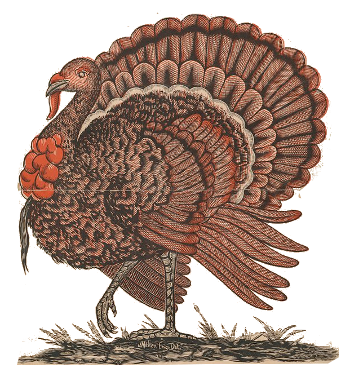
The common wild turkey is the Meleagris gallopavo.
The precise classification is Animalia, Chordata, Aves, Galliformes, Phasianidae, Meleagridinae, Meleagris.
(A late 19th century woodcut engraved by J. Molten, Library of Congress Catalog No. 2014645207, via Wikimedia Commons)
Physicists often solve difficult problems through simplification, a process that did not meet with the
approval of one of my
professors when I replaced a
Gaussian curve with a
triangle to make for an easier
calculation. This tendency is summarized in the
spherical cow parable that tells of a physicist who was assigned the task of increasing
milk production on a
dairy farm. He began the presentation his
research results with the phrase, "Consider a spherical cow."
A spherical cow would be hard to find, but some prepared turkeys have been likened to
balls, and balls are spherical. The
Butterball turkey is a
pre-brined turkey sold in
supermarkets. The
brining process, well known to
chefs, is a method to trap
moisture in
meat to promote
tenderness. Neither my
mother nor my
wife brined turkey, but they still
tasted great. They also filled the
cavity with a
bread stuffing, which is
safe to do when done with care.[2] One year, my
father decided to make an
Italian-style stuffing by adding
bell peppers. This wasn't a good
idea.
Turkey stuffing reminds me of a
Bazooka Joe comic I read as a
child. These comics were part of the
packaging for
Bazooka bubble gum. In that strip, Joe doesn't like the taste of a turkey
cooked by his
friend, Mort, so he asks what Mort used for stuffing. Mort replies that he didn't need to stuff it because it wasn't empty. People raised on supermarket
poultry might not get the
joke.
Food science is a
scientific disciple that combines elements of
chemistry,
physics, and
biochemistry, and its research has given us a better understanding of how to
prepare and cook food. While it's possible to do a
sous-vide of a whole turkey, this takes nearly an entire day and is recommended only for those with the proper
equipment and diligent
temperature monitoring. No matter how you cook your turkey, you need to know how long this will take. Reading the information of the
plastic wrapper solves that problem; but, what's the physics behind those times?
The
United States Department of Agriculture recommends that the minimum internal temperature of a turkey after cooking should be 165
°F (74
°C). The
heat capacity of a turkey determines how long it will take it to reach that temperature when absorbing
heat from the high temperature
heat reservoir of the
oven air. The heat capacities
Cp of
turkey, some other
meats,
Salmon,
shrimp, and
swwordfish, are listed in the table, below.[3]
The heat capacities of all these are quite close, with turkey having one of the lowest values by a small percentage. The similarity of turkey's heat capacity to that of pork seems to add
credence to the "
other white meat"
slogan for pork.
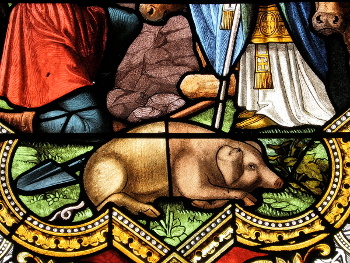
Stained glass pig at the Chapelle Notre-Dame-de-Lhor, Moselle, France.
This is a detail from a depiction of Saint Anthony the Great, a.k.a., Saint Antoine l'Ermite (Saint Anthony the Hermit).
(Photo by Pethrus, via Wikimedia Commons
Since I haven't done an
experiment in quite a while, I decided to measure the heat capacity of turkey meat. The table value, 2.81 kj/kg-°C, was likely done on uncooked turkey. Since I didn't want to work with that
material, I decided to do the experiment with
delicatessen sliced turkey, so I purchased a package of
Oscar Mayer DeliFresh Oven Roasted Turkey Breast. As a side benefit, I was able to
munch on some of the slices while waiting for my
data.
For my
measurement, I constructed a simple
calorimeter from items available to me in my
home workshop. A
diagram of the calorimeter is shown below. A
water bath is used as a heat reservoir whose temperature is monitored by an LM335
semiconductor temperature sensor.[4-6] I wrote about the LM335 is an
earlier article (Partial Solar Eclipse at New Jersey, August 24, 2017) in which I described my measurements of the
Solar eclipse of August 21, 2017. The calorimeter has a 50
ohm resistor that acts as a heat
calibration source. When excited by fifteen
volts, the resistor produces 4.5
watts (
joules per
second) of heat.
Stirring is provided for the uniform distribution of heat.
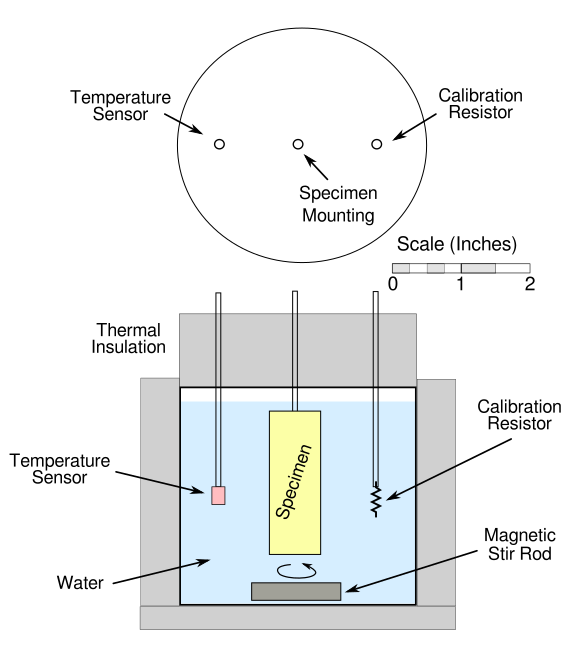
Diagram of the calorimeter for measuring the heat capacity of turkey. (Created using Inkscape. Click for larger image.)
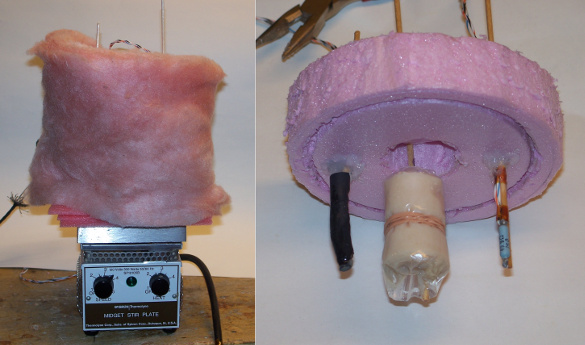
Pretty in pink. The left image shows how fiberglass thermal insulation is used to isolate the calorimeter from the environment. The calorimeter sits atop a piece of Styrofoam on a magnetic stirrer. This Styrofoam platform was necessarily thin to allow functioning of the magnetic stirrer, and this resulted in some temperature drift. The right image shows a detail of the top Styrofoam insulating cap with (left the right) the temperature sensor, the turkey meat specimen enclosed in a thin plastic pouch, and the calibration resistor.
The measurement concept is simple. A turkey meat specimen (17
grams in this case) is first cooled in an external low temperature water bath. When the specimen is then immersed in the calorimeter, it warms by drawing heat from the calorimeter water. The temperature drop of the calorimeter water allows a
calculation of the heat capacity. The calibration resistor was energized for two minutes at the start and end of the experimental data collection. Shown below is the
conventional method for data extraction from the drifting baseline. The data were taken using an
analog-digital converter attached to a
computer serial port.
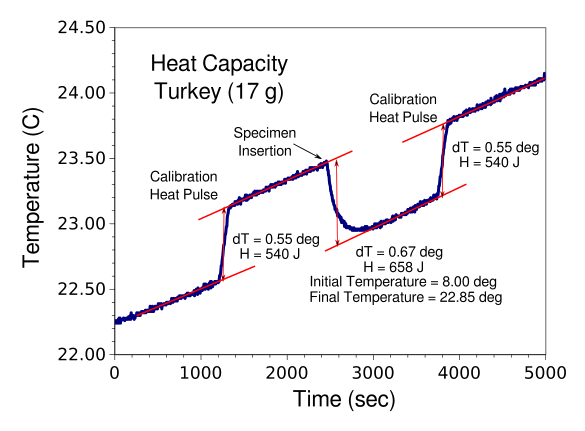
experimental data for the turkey meat heat capacity measurement. Since I couldn't assume that the heat capacity of the calorimeter water bath wouldn't change after immersion of the specimen, I did a calibration both at the start and end. There wasn't any change. (Click for larger image.)
Once the heat extracted by the specimen is found, the heat capacity
Cp is easily calculated:
Cp = (ΔH/ΔT) = 658j/(22.85-8.00)°C = 44.3 j/°C
44.3 j/°C/17 g = 2.61 j/°C/g = 2.61 kj/kg-°C
This value of 2.61 is strikingly close to the table value of 2.81.
References:
- Did Benjamin Franklin Want the National Bird To Be A Turkey?, The Franklin Institute Website.
- Turkey Basics: Stuffing, United States Department of Agriculture, Food Safety and Inspection Service Website.
- Specific Heat of Food and Foodstuff, The Engineering ToolBox Website.
- LM335 datasheet at Texas Instruments (PDF File).
- LM335 datasheet at STMicroelectronics (PDF File).
- LM335 datasheet at Jameco Electronics (PDF File).
Linked Keywords: Thursday; week; Thanksgiving (United States); United States; tradition; traditional; meal; holiday; turkey (bird); legend; Benjamin Franklin (1706-1790); Founding Fathers of the United States; bald eagle (Haliaeetus leucocephalus); National Bird; letter (message); daughter; vanity; vain; silliness; silly; courage; wild turkey; Meleagris gallopavo; taxonomy (biology); classification; Animalia; Chordata; Aves; Galliformes; Phasianidae; Meleagridinae; Meleagris; 19th century; woodcut; engraving; engraved; Library of Congress Catalog No. 2014645207; physicist; approval; professor; Gaussian function; Gaussian curve; triangle; calculation; spherical cow; parable; milk; dairy farm; research; ball; Butterball turkey; brining; pre-brined; supermarket; brining process; chef; moisture; meat; tenderness; mother; wife; sense of taste; body cavity; bread; stuffing; food safety; father; Italian cuisine; Italian-style; bell pepper; idea; Bazooka Joe; comic strip; child; food packaging; Bazooka (chewing gum); bubble gum; cooking">cook; friend; poultry; joke; Food science; branches of science; scientific disciple; chemistry; physics; biochemistry; food preparation; sous-vide; home appliance; equipment; temperature; plastic; United States Department of Agriculture; Fahrenheit; °F; Celsius; °C; heat capacity; heat; thermal reservoir; heat reservoir; oven; atmosphere of Earth; air; turkey as food; meat; salmon as food; shrimp and prawn as food; swordfish as food; food; beef; patty; hamburger; chicken as food; broiler; Guineafowl; Guinea hen; leg of lamb; pork; ham; pork loin; cuniculture; rabbit; sausage; veal loin; venison; credence; the other white meat; slogan; stained glass; pig; Saint Anthony the Great; Pethrus; Chapelle Notre-Dame-de-Lhor; experiment; material; delicatessen; Oscar Mayer; munch; data; measurement; calorimeter; home; workshop; diagram; laboratory water bath; semiconductor device; thermometer; temperature sensor; Solar eclipse of August 21, 2017; ohm; resistor; calibration; volt; watt; joule; second; stirring; Inkscape; pretty in pink; fiberglass; thermal insulation; environment (biophysical); Styrofoam; magnetic stirrer; temperature drift; plastic; packet (container); pouch; calibration; resistor; gram; calculation; convention (norm); conventional; analog-to-digital converter; computer; serial port.